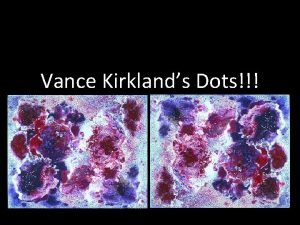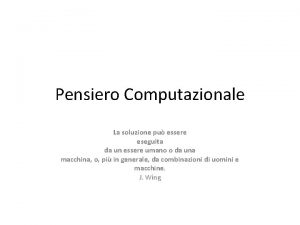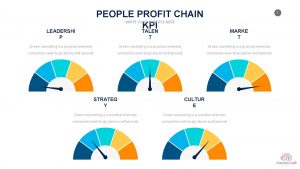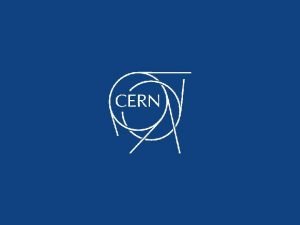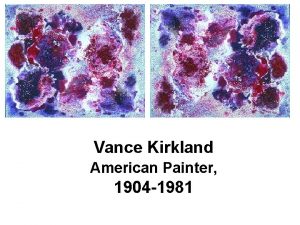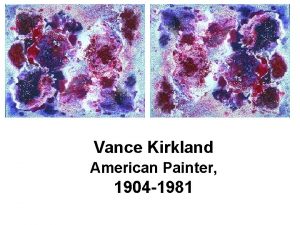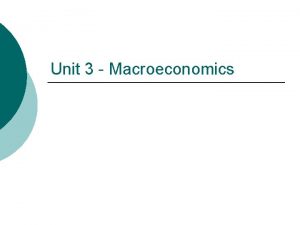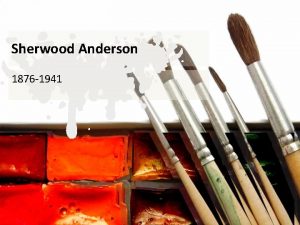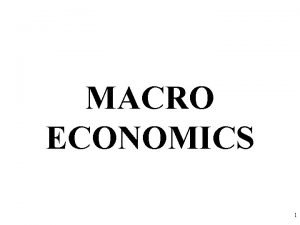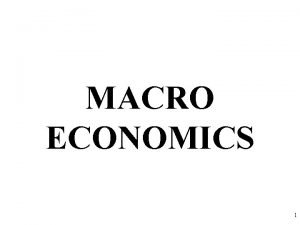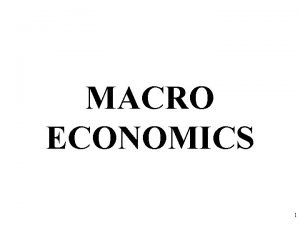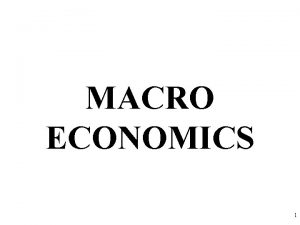MACROECONOMICS Presenter Kirkland Anderson Associate Professor of Economics





































- Slides: 37

MACRO-ECONOMICS Presenter: Kirkland Anderson Associate Professor of Economics & Management

UNIT ONE NATIONAL INCOME ACCOUNTING

NATIONAL INCOME National income is a measure of the monetary value of the flow of output of goods and services produced in an economy over a period of time. Measuring the level and rate of growth of national income (Y) is important for seeing:

• The rate of economic growth • Changes to average living standards • Changes to the distribution of income between groups within the population

NATIONAL INCOME {GDP} • Total income earned by the factors of production. • • Land Labor Capital Entrepreneurship

COMPONENTS OF NATIONAL INCOME (NI) STATISTICS • • Compensation of employees…. . LABOR Proprietors’ income…. CAPITAL Rental income…. LAND Corporate profits…. . CAPITAL Net interest…. CAPITAL Indirect taxes minus subsidies Net business transfer payments Surplus of government enterprises

NATIONAL INCOME (NI) STATISTICS • NI measures the standard of living in any economy. • The higher the value, better the standard of livings.

OTHER MEASURES OF ECONOMIC GROWTH / STANDARD OF LIVING • Gross National Product • Gross Domestic Product • Net National Product • National Income per Capita

GROSS DOMESTIC PRODUCT {GDP} • Total monetary value of all final goods and services produced within an economy over a period of one year • GDP = C + I + G + X - M

GROSS NATIONAL PRODUCT {GNP} • Total monetary value of all final goods and services produced by an economy over a period of one year. • GDP PLUS NET FACTOR PRODUCT FROM ABROAD {GNP = GDP + Net factor income from abroad}. • GNP = C + I + G + X - M

NET NATIONAL PRODUCT • The monetary value of finished goods and services produced by a country's citizens, whether overseas or resident, in the time period being measured (i. e. , the gross national product, or GNP) minus the amount of GNP required to purchase new goods to maintain existing stock (i. e. , depreciation).

• NNP = GNP – DEPRECIATION • Net National Product (NNP) can also be calculated as total payroll compensation + net indirect tax on current production + operating surpluses.

N. I. AT FACTOR COST or NET NATIONAL PRODUCT (NNP) AT FACTOR COST • The sum of wages, rent, interest and profits paid to factors for their contribution to the production of goods and services in a year. It may be noted that: • NNP at Factor Cost = NNP at Market Price – Indirect Taxes + Subsidies.

N. I. AT FACTOR COST or NET NATIONAL PRODUCT (NNP) AT MARKET PRICE • NNP is the market value of all final goods and services after providing for depreciation. That is, when charges for depreciation are deducted from the GNP we get NNP at market price. Therefore’ • NNP = GNP – Depreciation • Depreciation is the consumption of fixed capital or fall in the value of fixed capital due to wear and tear.

NATIONAL INCOME PER CAPITA Total NI or GDP per annum divided by total population

JAMAICA NATIONAL INCOME {GDP}/CAPITA BETWEEN 2000 & 2012 YEAR NI YEAR NI 2000 3, 310 2007 5, 831 2001 3, 300 2008 4, 720 2002 3, 366 2009 4, 510 2003 3, 412 2010 4, 570 2004 3, 785 2011 4, 760 2005 4, 326 2012 5, 140 2006 4, 978 Source: http: //data. worldbank. org/country/jamaica

CALCULATION OF NI • EXPENDITURE APPROACH • INCOME APPROACH

INCOME APPROACH This approach calculates National Income, NI. NI is the sum of the following components: Labor Income (W) Rental Income (R) Interest Income (i) Profits (PR) NI = W + R + i + PR • Labor Income (W): Salaries, wages, and fringe benefits such as health or retirement. This also includes unemployment insurance and government taxes for Social Security.

• Rental Income (R): • • • This is income received from property received by households. Royalties from patents, copyrights and assets as well as imputed rent are included. Interest Income (i): Income received by households through the lending of their money to corporations and business firms. Government and household interest payments are not included in the national income. Profits (PR): The amount firms have left after paying their rent, interest on debt, and employee compensation. GDP calculation involves accounting profit and not economic profit.

DETERMINATION OF NI: THE EXPENDITURE APPROACH Components of GDP, 2002: The Expenditure Approach Personal consumption expenditures (C) Durable goods Nondurable goods Services Gross private domestic investment (l) Nonresidential Residential Change in business inventories Government consumption and gross investment (G) Federal State and local Net exports (EX – IM) Exports (EX) Imports (IM) Total gross domestic product (GDP) Note: Numbers may not add exactly because of rounding. 20 of 38 U. S. Department of Commerce, Bureau of Economic Analysis. Source: BILLIONS OF DOLLARS PERCENTAGE OF GDP 7303. 7 871. 9 2115. 0 4316. 8 1543. 2 1117. 4 471. 9 3. 9 1972. 9 693. 7 1279. 2 - 423. 6 1014. 9 1438. 5 10446. 2 69. 9 8. 3 20. 2 41. 3 14. 8 10. 7 4. 5 0 18. 9 6. 6 12. 2 - 4. 1 9. 8 13. 8 100. 0

NOMINAL AND REAL DATA • Nominal values—such as nominal wages or (nominal) gross domestic product—refer to amounts that are paid or earned in money terms. • The nominal value of a commodity bundle in a given year may be expressed in prices and quantities, namely, as a sum of prices times quantities for the different commodities in the bundle{INFLATION IS NOT TAKEN INTO ACCOUNT}

REAL DATA • Real values represent the purchasing power of nominal values in a given period, including wages, interest, or total production. In particular, price indexes are typically calculated relative to some base year. • Real interest rates are measured as the difference between nominal interest rates and the rate of inflation.

OTHER INDICATORS OF LIVING STANDARDS AND ECONOMIC DEVELOPMENT • Standard of living …. the level of wealth, comfort, material goods and necessities available to a certain socioeconomic class in a certain geographic area.

• THE STANDARD OF LIVING INCLUDES FACTORS SUCH AS: • INCOME, • AVAILABILITY OF EMPLOYMENT • CLASS DISPARITY • POVERTY RATE

• QUALITY AND AFFORDABILITY OF HOUSING • HOURS OF WORK REQUIRED TO PURCHASE NECESSITIES, GROSS DOMESTIC PRODUCT • INFLATION RATE • NUMBER OF VACATION DAYS PER YEAR • AFFORDABLE (OR FREE) ACCESS TO QUALITY HEALTHCARE.

• AVAILABILITY OF EDUCATION • LIFE EXPECTANCY • INCIDENCE OF DISEASE • COST OF GOODS AND SERVICES • INFRASTRUCTURE • NATIONAL ECONOMIC GROWTH

• ECONOMIC AND POLITICAL STABILITY • POLITICAL AND RELIGIOUS FREEDOM • ENVIRONMENTAL QUALITY • CLIMATE AND SAFETY. THE STANDARD OF LIVING IS CLOSELY RELATED TO QUALITY OF LIFE

DIFFICULTIES IN MEASURING NI • The first problem relates to the treatment of non-monetary transactions such as the services of housewives and farm output consumed at home. • The second difficulty arises with regard to the treatment of the government in national income accounts. • The third major problem arises with regard to the treatment of income arising out of the foreign firm in a country.

DIFFICULTIES IN MEASURING NI IN UNDERDEVELOPED COUNTRIES • The first difficulty arises because of the • • prevalence of non-monetised transactions in such countries so that a considerable part of the output does not come into the market at all. Because of illiteracy lack of differentiation in economic functioning. production, both agriculture and industrial, is unorganized and scattered in these countries. lack of adequate statistical data. Inadequacy

CIRCULAR FLOW DIAGRAM

CIRCULAR FLOW An Economic Model which demonstrates the impact of the flow of money in and out of an economy. Everyone’s expenditure is someone else’s receipt. Every transaction must have two sides.



CIRCULAR FLOW OF INCOME • COMPONENTS OF CFI: • Household • Firm

CIRCULAR FLOW OF INCOME • It also consists of : • Inner flows • Outer flows

INNER FLOW • Firms pay households in the form of wages & salaries • Dividend on shares • Interest on rent • Consumers pay for the goods and services consumed.

OUTERFLOWS • Include: • Injections----eg. Investment (I), Government. spending, export revenues • Withdrawals----eg. Net savings, Government. taxes & import expenditures
 Promotion from associate professor to professor
Promotion from associate professor to professor Branch of economics
Branch of economics Gingivectomy definition carranza
Gingivectomy definition carranza Florida technology integration matrix
Florida technology integration matrix Vance kirkland paintings
Vance kirkland paintings Colgajo de widman modificado
Colgajo de widman modificado School of business and economics maastricht
School of business and economics maastricht What is mathematical economics
What is mathematical economics Associate systems engineering professional
Associate systems engineering professional To associate
To associate Los angeles harbor college admissions
Los angeles harbor college admissions Physician associate lecturer
Physician associate lecturer Associate consultant in capgemini
Associate consultant in capgemini Adobe spark certificate
Adobe spark certificate Tecniche associate al pensiero computazionale:
Tecniche associate al pensiero computazionale: Associate warden
Associate warden Harper college
Harper college Marine corps league red jacket
Marine corps league red jacket Disadvantage of direct mapping
Disadvantage of direct mapping Hea associate fellowship
Hea associate fellowship Critical reading active process of discovery
Critical reading active process of discovery Stratog online lectures
Stratog online lectures Mhp associate partner gehalt
Mhp associate partner gehalt Cincinnati state associate degrees
Cincinnati state associate degrees What does this drawing indicate about the inca civilization
What does this drawing indicate about the inca civilization Sales profit chain
Sales profit chain Iter project associate
Iter project associate Associate's degree in the netherlands
Associate's degree in the netherlands Cipd self-assessment examples
Cipd self-assessment examples Pjas cern
Pjas cern Associate consultant in capgemini
Associate consultant in capgemini برنامهxx
برنامهxx Rekenhulp tegemoetkoming scholieren
Rekenhulp tegemoetkoming scholieren Ruckus certification training
Ruckus certification training Associate of applied science in nursing block vs integrated
Associate of applied science in nursing block vs integrated Imeche associate membership
Imeche associate membership Michelin aad program
Michelin aad program Associated consulting engineers
Associated consulting engineers




